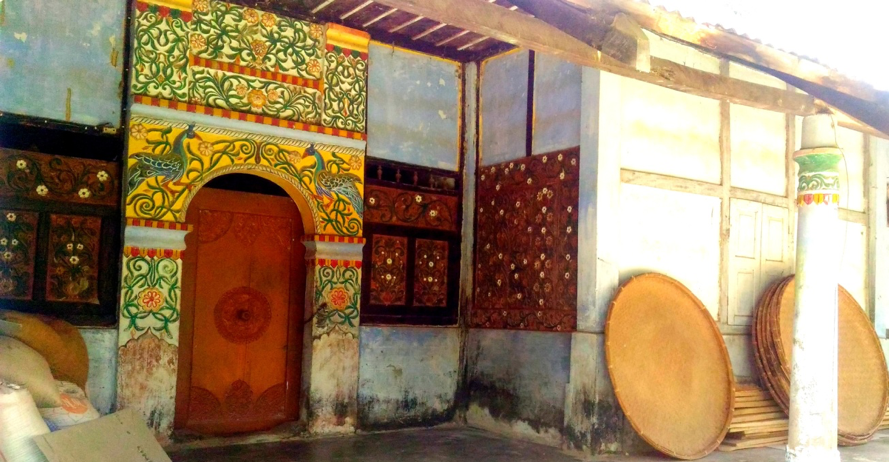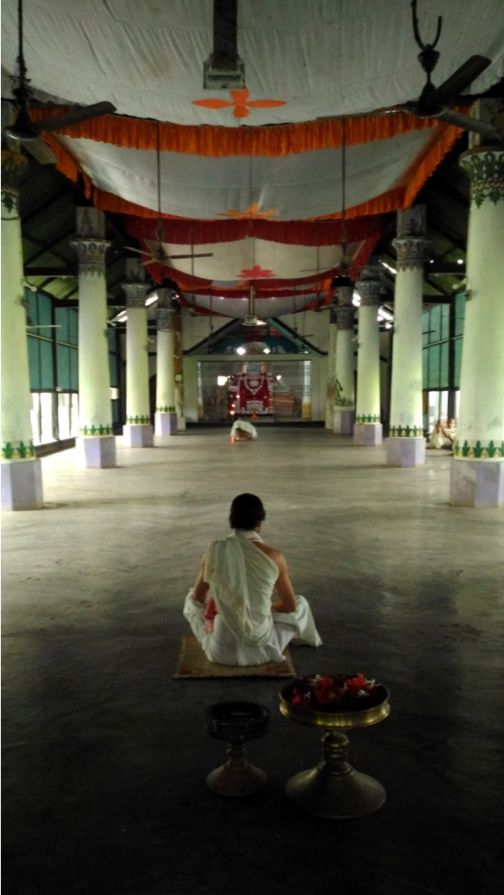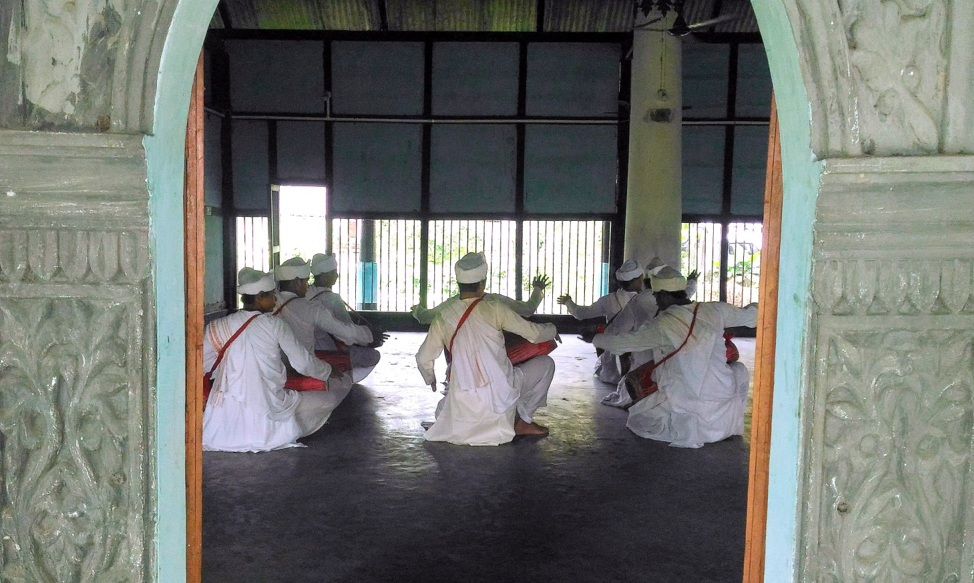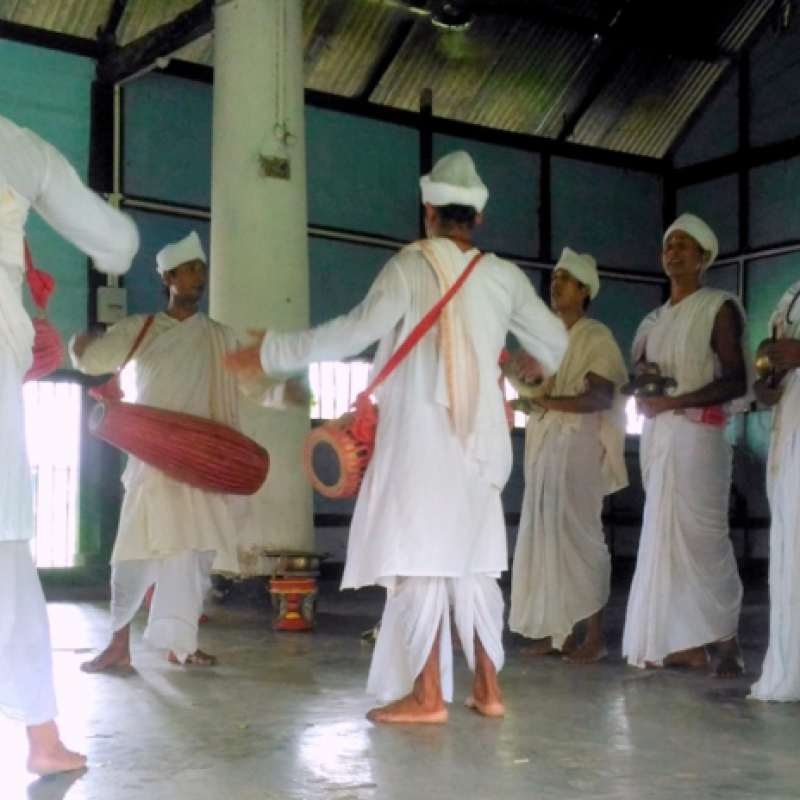Sattras are monastic institutions of the neo-Vaishnavite tradition that serve as socio-religious and cultural centres in Assam. An integral part of Assamese life and culture, sattras are repositories of the ancient religious philosophy and artistic expressions attached to it.
The neo-Vaishnavite tradition, a strand of the pan-Indian Bhakti movement, began in Assam as a religious and social reform movement in the fifteenth and sixteenth centuries. It was led by the saint Srimanta Sankardeva (1449–1568), an apostle for an egalitarian society. The movement has been called the ‘cultural renaissance’ of Assam as it ushered in the development of new genres of music, dance and folk theatre.[1]
The devotees, known as bhakats, gathered at the sattras to offer prayers and perform before the almighty. According to cultural scholars, the entire array of religious, social and cultural reforms emanating from the neo-Vaishnavite movement crystallised around these monasteries.[2]
Although sattras comply with basic principles and tenets of the neo-Vaishnavite tradition, they have their distinct identity and a separate historical trajectory. Some sattras, like Dakshinpath, for instance, won the royal patronage of kings and are repositories of many objects of antiquity and scriptures while other sattras like Kamalabari and Bhogpur are well known for the rigour with which the art forms of the Sankardeva tradition are perpetuated. The organisational structure and refined aesthetics of the sattras suggest that they have evolved over the years to stay relevant in the changing sociocultural landscape of the state.
To understand the emergence and evolution of sattras as multifaceted religio-cultural institutions, it is important to examine the reform movement led by Sankardeva.
Sankardeva and his Philosophy
Sankardeva was born to the Baro-Bhuyan class of non-Brahmin Hindu landlords in Assam. He espoused devotion, or bhakti to Krishna (an incarnation of Lord Vishnu), and inculcated a doctrine of salvation by faith, remembrance and prayer instead of sacrifices or idol worship as was practiced among orthodox Hindu Brahmins. To a large extent, this movement was aimed at social reform, spiritual elevation and ethnic consolidation when the region was fraught with ethnic tensions and disintegration. This form of bhakti, called the eka-sharana-naam-dhrama, entailed collective reverence through chanting, devotional singing and visualising forms of the divine entity. Eka-sharana-naam-dhrama was based on four main pillars—deva (god), naam (prayers), bhakats (devotees), and guru (teacher). It considered all devotees equal in the eyes of the God, who does not discriminate on the basis of jaati (caste). Sankaradeva hailed this aspect of neo-Vaishnavism as superior to the rituals practised among orthodox Hindus that were based on brahmanical codes and periodic pilgrimages.
Sankardeva travelled extensively across the northern regions of the Indian subcontinent to synthesise and consolidate his religious philosophy and ideas. The sattras became the nodal points of the movement. Most of them were built under the patronage of the then rulers, the Koch and Ahom kings. Maheshwar Neog, an Assamese-language scholar who specialises in the cultural history of Assam, compared the Vaishnava sattras to Shankaracharya’s[3] residential institutions called matha and Buddhist viharas, where monks resided, learnt and prayed.[4] He also suggested that sattras were unique multidimensional institutions, where devotees participated in religious discourses, sacred cultural practices, art and literature. The artistic forms and expressions—including dance, music, woodcarving, mask-making and theatre—that became an integral part of bhakti, were rooted in the existing folk and cultural traditions. Thus, they appealed to the people and were patronised by kings and noblemen. Sankardeva and Madhavdeva are also credited for developing new genres of devotional music called borgeet, nama-kirtana, and ankiya naat (theatrical performances) based on stories from the Mahabharata and Ramayana, and the dance form called Sattriya Nrittya. These art forms functioned as catalysts in promoting the faith, and were an integral part of reform and devotion. To make the ideas accessible to followers, Sankardeva delivered his preaching in Assamese instead of Sanskrit. But for his art forms, he created a new folk language called Brajavali, a mixture of Brajbhasha and Assamese. His magnum opus Kirtana-ghosha contains narrative verses in praise of Lord Krishna and is meant for community singing.
According to the earlier chronicles, Sankardeva established his first sattra at Bardowa, his birthplace. Later sattras were established across Assam as his disciples disseminated the ideas of the eka-sarana tradition. After Sankardeva, the movement and the message diversified and was carried forward by his disciples, Madhavdeva and Damodardeva.
Types of Sattras
Sattras fall under two major categories. Those where bhakats lead celibate lives are called udasin sattras. Those where the bhakats are not celibate and enter domestic life are called grihasti sattras. The Uttar Kamalabari sattra, Auniati sattra and Bhogpur sattra are udasin sattras, whose sattradhikar (head of the sattra) and bhakats practise celibacy, while the Garmur sattra in Majuli is a grihasti sattra.
On the basis of ideological leanings, sattras can broadly be categorised under four main sanghatis (denominations or sub-sects)—purusha sanghati, nika sanghati, kala sanghati and brahma sanghati. The purusha sanghati was initiated by Purusottama Thakura, eldest grandson of Srimanta Sankardeva. The sattras under this sanghati were established by those claiming to be direct descendants of Sankardeva.
The second order, nika sanghati, was founded by Mathuradas Burha-ata and Badaluwa Padma-ata, who organised their sattras following the conventions of Madhavdeva and his adherents, with great attention paid to cleanliness (nika) and purity.
Sattras established by Gopaldeva and his successors formed the kala sanghati. Prominent among them were Moamaria and Dihing sattras. Kala sanghati sattras were comparatively egalitarian in outlook, especially in matters of caste, and preached mainly among the tribes and other marginalised people of the region.
The brahma sanghati comprised the sub-sects of Damodardeva and Harideva, two Brahmin disciples of Srimanta Sankardeva. Most of the sattras affiliated to this sanghati are headed by Brahmin preceptors, and are considerably orthodox in their practice. This sanghati permits Vedic rites and devotional practices alongside nama-kirtana (devotional songs), and prioritises deva over the other three fundamental aspects—guru, nama and bhakat. The Auniati and Dakshinpat sattras in Majuli are part of this sanghati.
Architecture
Sattras are closed spaces with multiple buildings and four gateways. At the centre of the compound is the naamghar (congregational space or prayer hall), the most sacred building, used for public gathering, as a courtroom, or for performances and rituals. The living quarters are built around the naamghar. They run parallel to all the four sides, forming a perimeter. The residential quarters (haati) are built as a row of interconnected huts. The huts, or smaller independent units where the bhakats and members of the laity reside, are called boha. (Fig. 1)

The main entrance is called the karapat and is adorned with woodcarvings, paintings and sculptures of Jaya and Vijaya, divine gatekeepers in Hindu mythology.
The naamghar is typically a rectangular, two-roofed, thatched structure, about 50 feet long. The axis of the building usually runs from east to west. The ridged roof of the complex is supported by massive wooden pillars, and the doors and windows have open perforated walls and iron grills. During religious performances, devotees and spectators sit at the corridor. At the eastern end of the naamghar is the manikut (shrine), where the wooden throne or asana with a chandratap (canopy) over it is housed. The shrine is adorned with beautifully woven gamochas (a form of intricately embroidered local fabric) donated by devotees. A brass or bell metal lampstand known as akhyoybonti sits in front of the shrine. The asanas, or divine seats, are mainly of three types: the simhasana (lion-motif seat), guru asana (seat of the mentor Sankardeva or Madhavadeva), and amahapurusa asana (a seat of the supreme guru).
The manikut is considered the most sacred place of the premise. It houses precious items such as costumes and ornaments of idol(s), rare manuscripts, antiques and royal offerings, including the doba, kah (bell), tau (brass utensil), horai (tray for betel nut) and other valuables. At some sattras, relics of the early reformers are also preserved in the form of pada-sila (foot impression), a wooden plank containing the foot impressions or footwear of the early saints. Most rituals are conducted facing the manikut.
The interiors of the naamghars are decorated with paintings and woodcarvings with floral and geometrical designs. The wooden pillars are adorned with patterns made with khari-mati (chalk) and earthen colours. The woodcarvings represent anecdotes from Lord Krishna’s life, and the walls of the naamghars are painted with scenes from various Hindu mythological texts. (Fig. 2)

Batsora (a small, ridged roof hut) situated at the entrance of the naamghar, is often used to deliver important lessons and dance instructions to apprentices, and for debates. It is also a space for devotees to stand and witness the proceedings of the naamghar.
Another small room, cho-ghar (preparatory room), is situated on one side of the naamghar and serves as a dressing room for various occasions and festive performances like bhaona, ankiya-nat, oja-pali and Sattriya dances. Related accessories and props like costumes and ornaments are stored in this room.
Bharal (the main storehouse of the sattra) preserves dhaan (paddy) and other food items, and plays a critical role in ensuring supplies, especially in the face of natural calamities like floods. Most sattras have their own agricultural fields that help them self-sustain.
Organisation
The sattras followed a decentralised structure, with the sattradhikar as the main officiating head and the burhabhakats as the head of the household units.
The bhakats enter the sattra and are initiated as young apprentices who renounce their homes and learn the tradition of devotion and worship. They receive education not only from the Vaishnavite texts but also from the Vedas and Puranas and undergo rigorous training in the arts of the sattras.
The sattradhikar takes most of the administrative decisions and presides over important rituals. Other functionaries include the pathak (meaning reader), who imparts knowledge to the apprentices through discussions and occasional debates. The pathak recites from Bhagwata Purana during prayers and also reads from the Baktiratnawali, Kirtan-ghosha and Naam-ghosha. Those who listen to the pathak’s recitations are called sravanis (derived from the Sanskrit word sravana—to listen).
The natuwas (dancers) and sutradharas (actors) perform oja-pali, ankiya-nat and bhaona. The sutradhara is the main anchor in the plays and dances.
Scheduled and routine prayers, addresses and religious discourses among the disciples and the orator are conducted at the naamghars. They are also used as assembly halls to conduct seminars and discuss all matters related to the sattra and beyond, as well as to celebrate festivals and occasions. In many villages, naamghars also play the role of the local parliament.
The prayer announcements are made through the beating of doba (drum). The early morning prayer, called puar prasanga, is followed by the duporiya prasanga in the afternoon, which involves reading Bhagwata Purana. The afternoon prayer is followed by naam prasanga (congregational prayer) from Sankardeva’s Kirtana-ghosha. The last prayer of the day is called palnaam. This schedule is common to all sattras.
Performances held at the sattra include Sattriya dances and gayan-bayan—gayan, associated with singing, and bayan, playing the musical instruments bhortal (cymbals) and khol (drums). The gayan-bayan performances are held as part of the routine prayers but also on all auspicious occasions including festivals. It usually comprises a group of singers playing the bhortal and a group of percussionists and dancers who use movement and rhythm to complement the singers. (Fig. 3)

The bhakats also play the role of the deuri (priests). The deuri performs puja inside the manikut, and distributes the prasada (devotional offering) to devotees. The bharali is in charge of keeping records and maintaining the storehouse. The likhaks are the scribes and preservers of manuscripts, who make copies of old and rare texts.
The khanikars, a special class of artists among the bhakats, make illustrations or miniature paintings for the manuscripts. They are equally adept at woodcraft and are responsible for adorning the sattra premises. Khanikars also produce masks that are to be used in bhaona.
The majumdar, accountant and registrar of the sattra, issues orders to working groups of the bhakats and if required writes letters and responds to written communication from other sattras and the court.
The paldhariya and dwari are gatekeepers of the sattra and are responsible for the safety and security of its different units. These occupations are not fixed. A bhakat who is a dwari today might be a majumdar tomorrow.
Evolution
Sattras are vital to Assam’s culture. They are a part of the state’s intangible heritage as well as a repository of material wealth such as manuscripts and artefacts of immense historical value.[5]
They have constantly evolved to stay relevant. Apart from religious and cultural functions, the sattra members now also act as arbitrators during disputes and initiate welfare programmes in rural areas.
Sattras have gained new prominence as tourism destinations, and attract pilgrims from across the country. They are especially crowded during the festivals like Raas Utsav and the anniversaries of the gurus, when they present vibrant performances of Sattriya and bhaona.
While the bhakats through their guru–shishya (master–apprentice) tradition have passed on the knowledge of the neo-Vaishnavite philosophy and art forms down generations, their numbers have shrunk in most of the udasin sattras. Bhakats attribute this to several factors including the rise of nuclear families, fewer children and the aspiration to seek opportunities in the world through education.
Notes
[1] Bhuyan, Sankardeva and Neo-Vaishnavism, 2.
[2] Neog, The Contribution of the Sankardeva Movement.
[3] Shankaracharya was an Indian theologian and religious philosopher.
[4] Neog, The Contribution of the Sankardeva Movement.
[5] Nath, The Majuli Island Society, Economy, and Culture, 167.
Bibliography
Baruah, Girish. ‘Shaivism, Shaktism and Vaishnavism and their Origin and Development in State of Assam.’ The Mirror, no. 3. (2016): 52–69.
Bhuyan, Abhijeet. ‘Sankardeva and Neo-Vaishnavism in Assam.’ Ishani, no. 3 (2008): 1–10.
Gait, Edward. A History of Assam. Guwahati: EBH Publishers, 2008.
Gogoi, Nilanjana. ‘An Aesthetical Study on the Divine Sculptural Representations in the Vaisnavite Monasteries of Assam,’ International Journal of Innovative Research and Advanced Studies 3, no. 5 (2016).
Nath, D. The Majuli Island Society, Economy, and Culture. Delhi: Anshah Publishing House, 2009.
Nath, Rajmohan. The Background of Assamese Culture. Gauhati: Dutta, Baruah and Co., 1978.
Neog, Maheswar. The Contribution of the Sankardeva Movement to the Culture and Civilisation of India. Guwahati: Forum for Shankardeva Studies, 1998.
Neog, Maheswar. Early history of the Vaisnava Faith and Movement in Assam Sankardeva and His Times, Guwahati: LBS Publications, 1965.
Rahman, Mehjabeen. ‘Role of Satra and Namghar in the Evolution of Genesis of Assamese Identity.’ International Journal of Social Sciences and Management, no.2 (2013): 108–13.
Richmond, Farley. ‘The Vaiṣṇava Drama of Assam.’ Educational Theatre Journal 26, no. 2 (1974): 145–63.
Sharma, S.N. The Neo-Vaisnavite Movement and the Satra Institution of Assam. Guwahati: Lawyers Book Stall, 1966
Sharma, Pranalee, and Asha Singh. ‘Changing Notions of “Ideal” Monkhood: Case study from a Satra of Majuli.’ Space and Culture, no. 4 (2016): 29–38.

